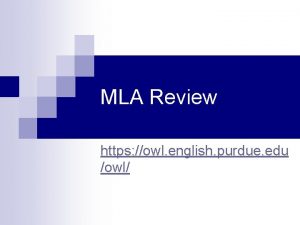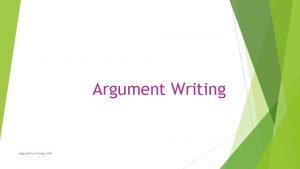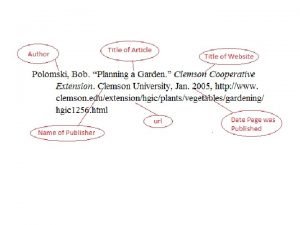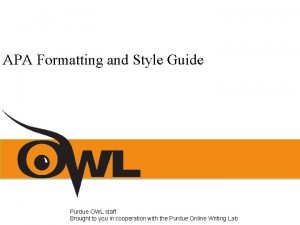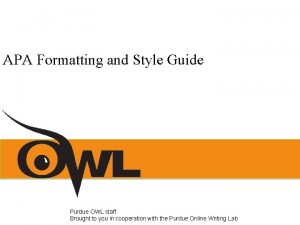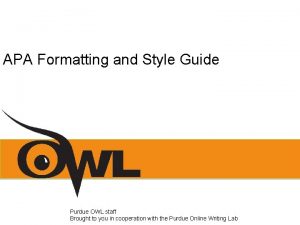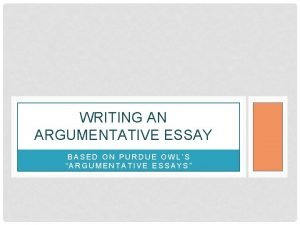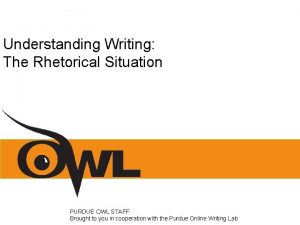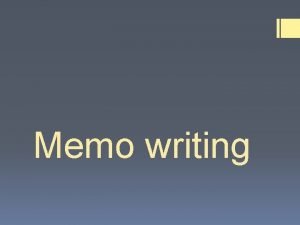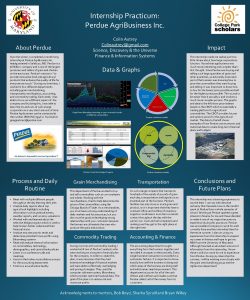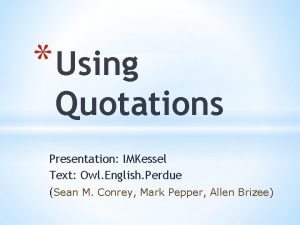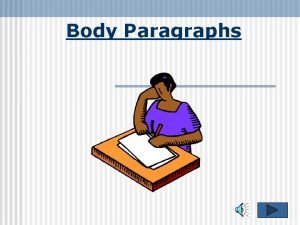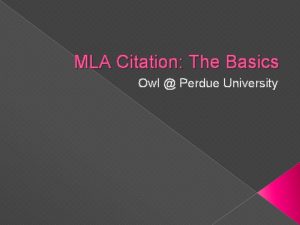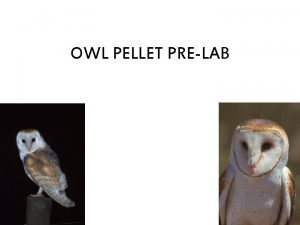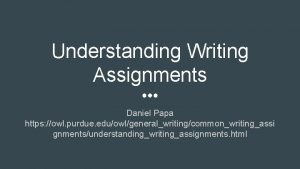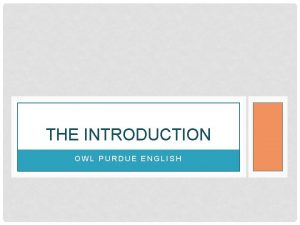OWL Perdue Paragraphs https owl english purdue eduowlresource6061















- Slides: 15

OWL Perdue - Paragraphs • https: //owl. english. purdue. edu/owl/resource/606/1/

Essay Development • Often, students struggle with essays that wind up too short, and they struggle to make word count without repeating themselves to death. • Students think they have to repeat themselves a lot in order to make minimum length—or else start talking about something completely off topic

• The real problem is that these essays lack depth - they are not “developed” • Rather than patiently developing each thought to its maximum potential before going on to the next logical thought, you’ve rushed the process, cheating yourself of the possibility of reaching the page length requirement and cheating the reader of being entertained by a meaningful essay.

A TEN STEP METHOD TO WELLDEVELOPED PARAGRAPHS

Step One • Make sure that you have a focus for that paragraph—a main point that this paragraph will focus on. • This should also connect back to your thesis in some way. • As support, example, etc.

Step Two • make a smooth transition into a paragraph that lays out your main focus for the paragraph as a controlling sentence (also called a topic sentence).

Step Three • in the same paragraph, state why the point is important • (this actually might be a linked sentence that is linked by “because, ” if there is a cause and effect relationship).

Step Four • Illustrate your point with an example: • From your own life/experience • Evidence from an outside source: Quote or Paraphrase from another text • Other types of examples/evidence

Step Five • State clearly why you used that illustration/example.

Step Six • Make sure you have been as specific as possible and have completely explained words, statements, or ideas that might be vague or unclear to your reader.

Step Seven • Decide what your next point is, thinking about what ideas might follow logically from this first body paragraph. • Use a transition that links the two ideas to each other, and repeat steps 2 – 6.

Step Eight • Continue in this fashion until you are ready for your conclusion.

Step Nine • Make sure your conclusion reviews the basic points/main ideas you want your reader to remember and think about after they are done reading.

Step Ten • REVISE to take out all empty “filler” words and to make sure each paragraph only contains sentences that relate specifically to that paragraph. • Check to make sure the order of the paragraphs follows some sort of logical organization—that each paragraph connects to the next and back to your thesis.

Example of detailed quote sandwich using 2 different sources and comparing them: Introduce quote from literature Quote w/in-text citation Analysis of quote Introduction of outside source Outside source quote w/in-text citation Analysis of quote and connection to thesis and main point The poverty that faces District 12 is vividly described in the novel. The narrator, Katniss, describes how the people are so hopeless and defeated that they have “hunched shoulders and swollen knuckles” and they have even “stopped trying to scrub the coal dust out of their broken nails [or] the lines of their sunken faces” (4). In this sentence, Suzanne Collins describes the conditions of poverty and hopelessness, using words like ‘sunken’ and ‘hunched. ’ All throughout the chapters that describe District 12 the language portrays a broken down people who have no hope because of their overwhelming poverty and hunger. Many readers may think that such poverty cannot exist in real life, or if it does it is only in other far-away countries. However, research into the poorest areas of America tells a different story. There are many communities and neighborhoods that are just as poor, oppressed, and downtrodden as District 12. In fact, there are many neighborhoods in the United States where the average salary per household is shockingly “below minimum wage” and even “two or three full time workers in a single household may not be enough to pay for basic necessities like rent, food, and medical care” (Scheckner). It is clear that although American Society may not be as obviously oppressive as the Capitol in The Hunger Games, there are still some very serious problems with our economic system when a hard-working family cannot even afford the basics without relying on credit cards, government aid, or working like a slave at more than one job.
 Owl.english.purdue.edu mla
Owl.english.purdue.edu mla Purdue owl paragraphs
Purdue owl paragraphs Owl.perdue
Owl.perdue Owl purdue
Owl purdue Owl purdue mla
Owl purdue mla Owl apa
Owl apa Purdue in text citations
Purdue in text citations Apa purdue owl
Apa purdue owl Perdue writing
Perdue writing Purdue owl abstract
Purdue owl abstract Purdue argumentative essay
Purdue argumentative essay Purdue owl works cited
Purdue owl works cited Rhetorical analysis purdue owl
Rhetorical analysis purdue owl There were fifteen candies in that bag
There were fifteen candies in that bag Sample memorandum subject purpose and audience
Sample memorandum subject purpose and audience Purdue literary theory
Purdue literary theory
